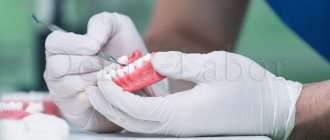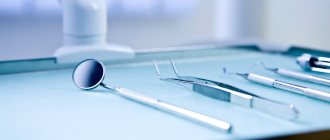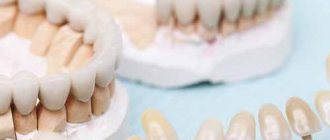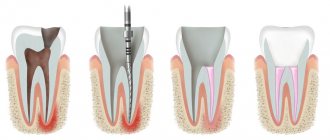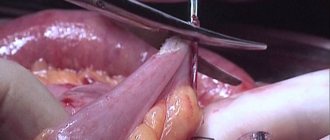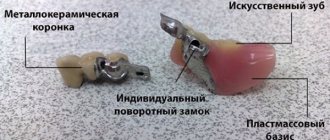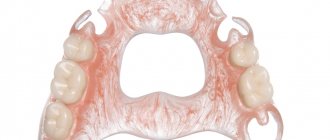According to statistics, in the first year of use, about 13–15% of prosthetic structures made of acrylic and 8–10% of modern thermoplastic materials break. Unfortunately, breakdowns always happen, as circumstances vary. Damage can be caused by injury, excessive load, or improper care of the structure. Many patients who are faced with this situation are interested in whether it is possible to glue a denture and how to do it.
What is a nylon prosthesis
Removable nylon dentures are soft orthopedic structures made of a pink, gum-colored nylon base with invisible clasps that hold it in the mouth. The fixation is on the adjacent teeth; the hooks wrap around the supports, keeping the prosthesis stationary on the jaw. Artificial crowns are placed on an elastic frame.
A person can take off and put on a nylon prosthesis without assistance. They are used in dentistry as a temporary solution during implantation (during the process of osseointegration) or as a permanent prosthesis according to indications.
Nylon is a polymer that has the quality of flexibility, and under certain conditions, in the patient’s mouth, softness increases. As a denture material, it has come as an alternative to dental acrylic, to which some people are allergic.
Partial nylon prosthesis RUR 40,000. for all!
The price includes: diagnostics, impressions, manufacturing, installation, fitting and 1 year warranty! Complete denture Akrifri 1 jaw - 47,000 rub.!
Stages of prosthetics
To produce a prosthesis that matches the patient’s personal parameters, several visits to our Center will be required.
- Diagnostics Visual examination, CT diagnostics, functional studies for malocclusion.
- Preparing the teeth In partial dentures, the abutment teeth are treated to withstand future stress.
- Taking impressions Impressions are taken, from which a wax model of the jaw and a prosthesis template are made.
- Determination of occlusion Using the facebow, central occlusion is determined and fixed. The artificial teeth are placed on a wax model in an articulator.
- Fittings The wax model is tried on to assess comfort and compliance with facial parameters, then in the laboratory the wax is replaced with nylon.
- Installation The prosthesis is fixed, the articulator is re-checked for jaw relationships. If there are any inaccuracies, the product is corrected.
During the adjustment period, additional adjustments may be required if there is discomfort. Our goal is to perfect the denture so that it feels like your own teeth in your mouth.
Stages of manufacturing a flexible prosthesis
To create nylon dentures, you must first treat the teeth, perform removal according to indications, and then proceed to the following steps:
- taking impressions of jaws in a clinical setting;
- plaster models are made in the laboratory;
- a wax prototype of the prosthesis is cast, tried on, and finalized;
- a nylon final version is created, matched to the color of the gum. The equipment used is a heat press, in which polymer granules are melted and an individual mold is poured in a liquid state. After hardening, the structure is polished.
Clasps are a continuation of nylon dentures and are therefore completely invisible on the jaw even when smiling and talking.
First steps in the event of a broken orthopedic structure
If the base part is broken, do not try to glue it together yourself. There are many “advisers” on the Internet, but it is not advisable to follow unprofessional recommendations. Otherwise, you may miss the opportunity to repair the product and permanently damage it. And then you will have to order a new prosthesis.
Therefore, first of all, contact the clinic where you installed this structure. An orthopedic dentist will provide you with professional assistance in this situation. At the reception specialist:
- inspect the damaged structure;
- will evaluate the possibility of repairing it;
- will inform you about further actions.
If the module is repairable, it will be sent to a dental laboratory. In just a couple of days, the integrity of the prosthetic system will be restored. If the warranty period has not expired, repairs are made free of charge.
It is not always possible to repair the base part; for example, it is almost impossible to repair old nylon dentures that are more than two years old. In this case, you will be offered the manufacture of a new product.
Indications for installation
Indications for removable nylon dentures can be:
- loss of one or more teeth in a row;
- scattered defect;
- absence of all teeth;
- allergy to metal, acrylic;
- if you do not want to grind the supporting teeth for dentures, for example, clasp ones with locks;
- periodontal disease of 1st and 2nd degrees to keep teeth in place (but 3.4 degrees will already be a contraindication);
- patient refusal or medical contraindications to implantation;
- childhood, if necessary, hide early tooth loss;
- as a temporary solution for implantation with delayed loading.
Sometimes nylon dentures can be installed to treat bruxism, involuntary grinding in the mouth, which damages tooth enamel and increases wear. And also for athletes and people involved in traumatic sports, a flexible design is the best option, better than acrylic, which can easily break in case of injury.
Why a prosthesis can be damaged/broken - common reasons
Like any other product, dentures sometimes break and fail, regardless of the model and design features of the device. There are many potential reasons for this problem, and here are the most common ones:
- a defect in the design itself as a result of an error made at the stage of its manufacture,
- incorrect installation of the product in the oral cavity,
- neglect of hygiene rules and lack of proper care of the structure,
- increased chewing load or careless handling of the orthopedic apparatus,
- injuries resulting from blows or falls,
- low quality of the material from which the orthopedic system is made,
- structural changes in supporting teeth - their loosening and destruction, including under the influence of caries or inflammatory processes in the gums.
You can break dentures by biting hard objects.
And here it should be noted that breakages are different and not all of them lead to complete failure of the product. Orthopedic dentistry specialists are engaged not only in the manufacture, but also in the repair of such devices, which often allows saving on complete re-prosthetics.
Contraindications
What may be a contraindication to a nylon prosthesis in dentistry:
- periodontal diseases (grade 3-4 periodontal disease), loose teeth, their displacement;
- recession;
- the height of the supporting teeth is not enough, the clasps will not be able to securely fasten;
- inflammatory processes of the mucous membrane and gums;
- tooth mobility;
- significant bone atrophy.
It is necessary to have healthy teeth on both sides of the prosthesis as supports for clasp fixation.
Computer diagnostics - for reliable data
It is performed on a GALILEOS tomograph (The Dental Company SIRONA, Germany).
- Assessment of bone tissue to determine the parameters of the prosthesis base
- Study of the position and functions of the temporomandibular joint
- Determination of the condition of abutment teeth during partial dentures
Varieties
There are:
- mini dentures for 1-2 teeth;
- partial (in the absence of three or more teeth);
- complete (replacing the dentition of the entire jaw).
Many people mistakenly believe that all flexible prostheses are nylon. This is wrong. They are very similar to the touch and in some characteristics. However, they should be considered separately.
Quadrotti prosthesis
A special modern type of prosthesis, which stands somewhere between clasp and nylon. It is more durable than the latter, has a little flexibility, and the fasteners are also not visible, unlike the clasp design, where, perhaps, this is the only drawback. The material of manufacture is monomer-free plastic.
Immediate prosthesis “butterfly”.
This is just a type of nylon prosthesis. It is used in cases where one, or less often, two teeth are missing. Small design, good replacement for a lost dental element. Produced quickly. The supporting teeth are not affected, that is, the doctor does not grind them down, they remain healthy and serve their term.
Own digital laboratory - speed and quality
The Center has a digital dental laboratory with a staff of experienced qualified dental technicians.
- Direct and immediate interaction between the orthopedist and the dental technician
- Highly accurate digital impressions without impression material errors
- Fast terms of prosthetics, no restrictions on the number of fittings
Rules of care and wearing features
In order for the prosthesis to look aesthetically pleasing throughout the entire period of use, you should adhere to simple rules for caring for it:
- brush your teeth and teeth 2 times a day;
- the toothbrush should have soft bristles and the toothpaste should be non-abrasive;
- After each meal, also clean the product or rinse your mouth with water if it is not possible to remove and thoroughly wash the denture;
- take it to the dentist for professional cleaning twice a year;
- do not store in a dry place;
- periodically use a special solution to disinfect and clean removable dentures.
What does denture repair involve?
Denture repair is a technical procedure for restoring the appearance, integrity and functionality of dentures, which is carried out in dental clinics or dental laboratories. Even the highest quality and most expensive products can fail for a number of reasons. Of course, in such cases it is necessary to repair them as quickly as possible, since not all patients keep a spare prosthesis in case the main one breaks. Fortunately, today many clinics provide emergency denture repair services.
Interesting fact!
According to statistics, modern dentures break in 10% of cases in the first year of use. Meanwhile, in the world, every second person over 35 years of age wears dentures, since between 35 and 45 years old, 68% of people lose at least one tooth.
Advantages
An undoubted advantage is the aesthetic appearance, better than that of acrylic and clasp structures. And:
- light weight, which is a significant factor for the upper jaw, where a person feels every gram of a foreign body;
- small basis. There is no wide part blocking the sky, like the plate analogue, which is much more comfortable;
- quick addiction is due to the two points above;
- “invisible prosthesis”, invisible to others, a person can laugh and talk without hesitation. Nylon, in this sense, is a good material; it perfectly imitates gums. And since the clasps are a continuation of the base and are of the same color, they are attached directly to the gums behind the supporting tooth, so they are not visible. What is an advantage over metal visible hooks of clasp structures and acrylic ones;
- hypoallergenic. The production does not use toxic monomers that are added to the plastic mass of acrylic prostheses. They are the ones who cause allergies in patients. By the way, other alternatives to prosthetics have appeared for such sensitive people - Acry Free;
- there is no metallic taste in the mouth due to the absence of metal in the composition;
- The next plus will be felt by people who have a small mouth. Opening it wide to install a large prosthesis is not very comfortable. But not in this case. Nylon bends easily and does not require such sacrifices from patients.
Flaws
It cannot be said that all the disadvantages that we describe below apply to mini-prostheses. They are the ones who receive the least number of complaints. But larger designs definitely have the following negative nuances:
- uneven load when chewing and discomfort when chewing food. The base is flexible and when bitten it bends even more, all the pressure goes to one area, which causes pain. Since the load is not distributed over the entire prosthetic bed, the tissues underneath it atrophy;
- rapid atrophy. Under any removable denture this process occurs and the height of the alveolar ridge is lost. You can find figures about 1mm per year. Loss of tissue leads to subsidence of the prosthesis;
- damage to the gums in the area of clamp fixation. Unlike the clasp type and the plate type, where the hooks wrap around the neck of the supporting tooth, nylon dentures have a gingival attachment. Therefore, the load when chewing is transferred not to the tooth, but to the gum, which over time injures it;
- a fairly rapid decline in aesthetics. Nylon scratches, becomes sticky over time, and attracts dirt;
- beyond repair;
- short service life - up to 5 years and at the same time the need for frequent corrections.
Features of removable denture repair
Removable dentures consist of a base made of silicone, nylon, or acrylic plastic, and directly artificial crowns (plastic, metal-ceramic or ceramic). Thus, a feature of the repair of removable dentures is that their base is a monolithic structure and it is quite difficult to repair it. As for the artificial crowns themselves, they are attached by soldering and therefore can be replaced quite easily and quickly. When artificial enamel is peeled or chipped, it is usually restored with composite materials.
Repair of clasp dentures is considered the most difficult among removable structures, since they contain quite a lot of cast metal elements. For example, if the cast arm of a clasp breaks off, it will have to be replaced with a similar bent element. However, it is important to note that if the arch of the structure is fractured, repair of the clasp prosthesis is impossible.
Expert opinion
Roman Borisovich Alekperov
orthopedic dentist
Experience: 24 years
The choice of flexible prostheses is based mainly on the patient’s desire to receive maximum comfort from wearing an orthopedic structure. Nylon or silicone prostheses do not require long-term adaptation - made from an individual cast, they immediately sit comfortably and allow you to chew food and speak normally. It is important to remember that long-term wearing of flexible prostheses can lead to the development of atrophic processes in bone tissue, since these structures do not have a rigid base. Do not use flexible dentures for more than 6-9 months if you are planning to have implants. If such a situation occurs and the bone is “gone,” it will be necessary to pre-build it or perform basal implantation.
Types and duration of repair of dental prostheses
Urgent repair of removable dentures sometimes does not require serious interventions and is carried out directly in the presence of the patient. This usually concerns the repair of acrylic dentures or Acri Free products, which are the easiest to restore. If the structure has metal elements, then the procedure will take much more time. For example, repairing metal-ceramic dentures can take more than a day.
Traditionally, dentistry, dental laboratories and denture repair shops provide the following range of services aimed at eliminating the breakdown of orthopedic structures.
| Type of repair | Duration |
| Repairing cracks in dentures | 1 – 2 hours |
| Repairing a broken product | 1–2 hours |
| Relining the prosthesis | 1 – 2 hours |
| Welding artificial crowns to the base | 15 hours |
| Welding a clasp to a removable denture | 15 hours |
| Repair of nylon dentures | up to 24 hours |
| Repair of metal-ceramic dentures | 1 – 2 hours |
Important!
For high-quality repairs and accurate restoration of the prosthesis, you must visit an orthopedic dentist before repairing.
Examples of work “Before” and “After”
Partial restoration of teeth on both jaws
Case: partial absence of teeth on both jaws.
Complete prosthetics of the upper and lower jaws
Case: absence of teeth in the upper jaw (completely), absence of an orthopedic structure in the lower jaw on existing implants (installed in the USA two years earlier) Work: production of a complete removable denture in the upper jaw as a temporary structure until the installation of one-stage implants with subsequent prosthetics.
Installation of plate dentures with complete edentia (April 2012)
Case: complete absence of teeth in the upper and lower jaws, weak fixation of the removable denture in the lower jaw.
Complete absence of teeth in the upper jaw
Case: Completely edentulous upper jaw Work: Complete removable plate denture - acrylic Number of visits: 4 Time: 2 weeks Cost: 25,000 rub.
Damage to artificial crowns
Most often, experts in the field of orthopedics have to work with breakdowns associated with a violation of the integrity of the structure. Moreover, different types of products are characterized by their own damage. As for crowns, they are characterized by the following problems:
- chips - the appearance of nervousness and roughness on the edges and chewing surface,
- cracks - thread-like defects most often result from too intense chewing load,
- change in color under the influence of coloring pigments - modern materials are less susceptible to staining, but without proper care and regular hygiene they risk losing their vibrant shine over time, becoming dull and darkening.
When choosing material for future crowns, the specialist must take into account the location of the defect, the expected intensity of the chewing load, the patient’s financial capabilities and other important factors. It is the material that largely determines the service life of the product and its performance characteristics.
The photo shows a chip on the crown
So, for example, single dentures made of metal-plastic, as well as plastic crowns, usually last no more than 3-5 years, but after a couple of months, many patients notice that the material begins to chip, gradually changes its color and loses its aesthetic appearance.
All-ceramic crowns are also susceptible to chips and cracks, which is explained by the insufficiently high strength of the material, which is often unable to cope with increased chewing loads. Therefore, such prosthetic structures are recommended for restoration of the smile area. In this regard, metal-ceramics is a more preferable option for restoring chewing teeth, however, even here, none of the patients are immune from chips of the ceramic veneer.
The most durable models are considered to be single prostheses made of zirconium dioxide. They are not only extremely durable, but also aesthetically pleasing, suitable for installation both in the distal parts of the jaws and in the frontal zone, and their service life can reach 15-20 years or more.
Products made from what materials can be repaired?
The possibility of repairing an orthopedic structure largely depends on the material from which it is made. For example, acrylic models, which themselves are quite fragile, can be repaired. In this case, cracks are usually covered with self-hardening resins. As for nylon prosthetic devices, their repair, as a rule, involves eliminating chips and cracks on the crowns. Since the base in such products is quite elastic, it is less susceptible to breakage. On the other hand, due to their increased elasticity, such prostheses quickly stretch and lose their original shape, which reduces the strength of their fixation and requires frequent relining.
Plastic crowns are less strong and durable, but metal-ceramic crowns are considered more reliable, but this also has its own nuances. For example, ceramic cladding tends to chip under intense chewing load. Such defects are restored by applying luminous composite materials. Modern materials (adhesives, adhesives and cement compositions, photopolymers) allow the reconstruction of dentures to be carried out quickly and with high quality, which is also helped by advanced computer programs, specialized equipment and tools.
How to repair fixed structures
Fixed orthopedic systems include artificial crowns, bridges, as well as microprostheses: restoration inlays, veneers and lumineers. Any prostheses attached to implants can be included in this category. If, if the integrity or fastening of implant systems is damaged, a complete re-treatment has to be carried out, then crowns and “bridges” can most often be repaired.
Crown restoration
In the event of a chip, the broken fragment is returned to its place and secured using a photopolymer composite. If there is no chipped piece, the doctor will simply restore the shape of the orthopedic product using the same material. Of course, repairing artificial teeth is much cheaper than replacing them completely.
Using a special material, a specialist hides the defect
As for the repair of fixed single dentures, there are two options: with and without removable ones. The problem is that when removing the product there is a risk of further damage to it, especially if we are talking about an all-ceramic model. On the other hand, modern equipment allows de-cementing to be carried out extremely carefully and with minimal risks. However, if the situation allows, repairs are carried out directly in the patient’s oral cavity.
Repair of "bridges"
Restoring bridge structures usually involves restoring artificial teeth. If the base is fractured, the product must be completely replaced, which is also true for cases of destruction of supporting teeth.
